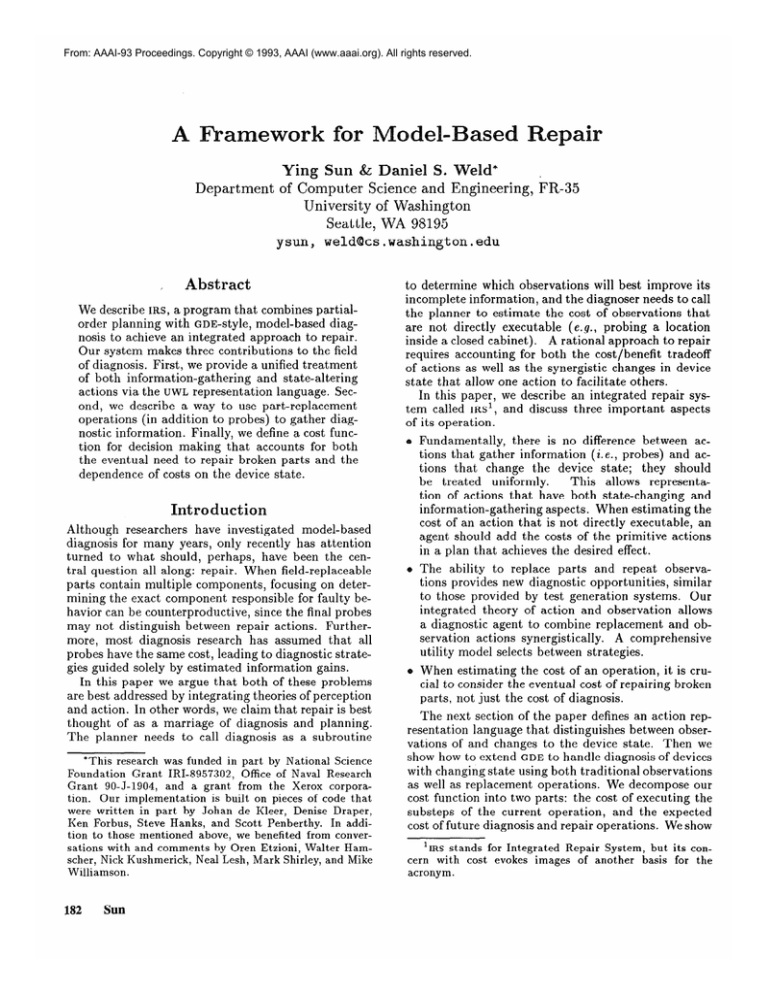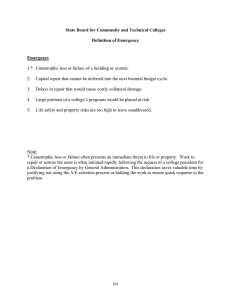
From: AAAI-93 Proceedings. Copyright © 1993, AAAI (www.aaai.org). All rights reserved.
Ying Sun & Daniel S.
Department of Computer Science and Engineering,
University of Washington
Seattle, WA 98195
ysun J weld@cs.washington.edu
,
Abstract
We describe IRS, a program that combines partialorder planning with GDE-style, model-based
diagnosis to achieve an integrated approach to repair.
Our system makes three contributions
to the field
of diagnosis. First, we provide a unified treatment
of both information-gathering
and state-altering
actions via the UWL representation
language. Second, we describe a way to use part-replacement
operations (in addition to probes) to gather diagnostic information.
Finally, we define a cost function for decision making that accounts for both
the eventual need to repair broken parts and the
dependence of costs on the device state.
Introduction
Although researchers
have investigated
model-based
diagnosis for many years, only recently has attention
turned to what, should, perhaps, have been the central question all along: repair. When field-replaceable
parts contain multiple components,
focusing on determining the exact component responsible for faulty behavior can be counterproductive,
since the final probes
may not distinguish between repair actions.
Furthermore, most diagnosis research has assumed that all
probes have the same cost, leading to diagnostic strategies guided solely by estimated information
gains.
In this paper we argue that both of these problems
are best addressed by integrating theories of perception
and action. In other words, we claim that repair is best
thought of as a marriage of diagnosis and planning.
The planner needs to call diagnosis as a subroutine
*This research was funded in part by National Science
Foundation
Grant IRI-8957302,
Office of Naval Research
Grant 90-J-1904,
and a grant from the Xerox
corporation. Our implementation
is built on pieces of code that
were written in part by Johan de Kleer, Denise Draper,
Ken Forbus, Steve Hanks, and Scott Penberthy.
In addition to those mentioned
above, we benefited from conversations with and comments
by Oren Etzioni, Walter Hamscher, Nick Kushmerick,
Neal Lesh, Mark Shirley, and Mike
Williamson.
182
Sun
FR-35
to determine which observations
will best improve its
incomplete information,
and the diagnoser needs to call
the planner to estimate the cost of observations
that
are not, directly executable
(e.g., probing a location
A rational approach to repair
inside a closed cabinet).
requires accounting for both the cost/benefit
tradeoff
of actions as well as the synergistic
changes in device
state that allow one action to facilitate others.
In this paper, we describe an integrated repair sysaspects
tem called IRS', and discuss three important
of its operation.
Fundamentally,
there is no difference between acthat gather information
(i.e., probes) and actions that change the device state;
they should
This
allows represent abe treated
uniformly.
tion of actions that have both state-changing
and
information-gathering
aspects. When estimating the
cost of an action that is not directly executable,
an
agent should add the costs of the primitive actions
in a plan that achieves the desired effect.
tions
The ability to replace parts and repeat observations provides new diagnostic opportunities,
similar
to those provided by test generation
systems.
Our
integrated
theory of action and observation
allows
a diagnostic agent to combine replacement
and observation actions synergistically.
A comprehensive
utility model selects between strategies.
When estimating the cost of an operation, it is crucial to consider the eventual cost of repairing broken
parts, not just the cost of diagnosis.
The next, section of the paper defines an action representation language that distinguishes
between observations of and changes to the device state.
Then we
show how to extend GDE to handle diagnosis of devices
with changing state using both traditional observations
as well as replacement
operations.
We decompose our
cost function into two parts: the cost of executing the
substeps of the current operation,
and the expected
cost of future diagnosis and repair operations.
We show
‘IRS stands for Integrated
Repair System,
but its concern with cost evokes images
of another
basis for the
acronym.
how the UCPOP
planner [Penberthy
and Weld, 19921
can be used to calculate this cost function,
and we
illustrate our algorithm on two simple refrigerator
[Althouse et al., 19921 examples. After discussing the implementation,
we close with a discussion of related and
future work.
odeling
Action
and Change
The first step in creating a unified theory of repair is to
select a generalized model of action that distinguishes
between causal and information-gathering
effects. For
example, it is crucial to differentiate
between an observation that the voltage of a node is zero and an
action that grounds the node. Even though the agent
knows the voltage is zero in both cases, the effects are
very different.
Traditional
diagnosis systems do only
the former, while most implemented
planners handle
only the latter; an integrated repair system needs both.
Even though a whole AI research subfield is devoted to
representations
of action [McCarthy and Hayes, 19691,
most existing theories do not meet our needs:
1. Ability
to represent
incomplete
information.
2. Distinguish between observations (which increase information,
but, don’t change the world state) and
actions with causal effects.
3. Computationally
tractable.
For example,
although
the STRIPS representation
satisfies the last criterion, it assumes complete information and thus renders the notion of observation meaningless.
[M oore, 19851 develops a first-order
modal
logic that codifies actions that supply an agent with
information,
and [Morgenstern,
19871 presents a more
expressive language that allows actions to have knowledge preconditions,
but neither researcher considers algorithms for generating plans using their models of action.
Our UWL representation
[Etzioni et al., 19921 is perfectly suited to the needs of repair.
An extension of
STRIPS that, handles incomplete
information,
UWL
was
originally designed to represent UNIX commands for a
Softbot [Etzioni and Segal, 19921. The novel aspects of
the language include annotations
to differentiate causal
from observational
effects and informational
from causational goals, T, F, and U truth values, and run-time
variables.
For example, one might write the goal or precondition of setting the voltage of V to 220 with (satisfy
(value-of
V 220))
while the goal of determining
the current voltage at that probe point can be written as (f indout
(value-of
V ?x) ) . Similarly,
the
effect of an action that grounds a node might be
(cause
(value-of
V 0) ) while a step that just observes the value without changing it would be written
as (observe
(value-of
V ! y)).
In these examples,
?x denotes a plan-time variable whose value ma be
constrained during subsequent planning decisions 9Stefik, 19811, but !y denotes a run-time variable that is
treated as an (unknown) constant by the planner and
whose value is only established
when the plan is executed.
Abstractly,
a UWL step schemata contains a
step name, a set of preconditions,
and a set of postconditions
(with associated
cost).
Preconditions
and
goals are annotated
with satisfy
or f indout;
postconditions are annotated with cause and observe.
Initial conditions are represented with a dummy step that
has no preconditions
and whose postconditions
cause
all propositions
to take on some truth value, U in the
case of incomplete information.
Complete details and
formal semantics are provided in [Etzioni et al., 19921.
To illustrate
the use of UWL,
we show a simplified version of part of our refrigerator
domain theory.
When the argument ?x of a measure step is an internal voltage, the probe cost is 5.2 A measure step also
causes the proposition
(probed
?x) to be true and
sets ?x to !v, a run-time variable whose value will be
determined during plan execution.
(define-step
:when (and
(measure
(satisfy
(satisfy
(and (cause
(observe
:effect
:cost
?x)
(internal-voltage
?x))
(not
(backplane-on))))
(probed
?x>>
(value-of
?x !v))>
5)
iagnosis with Changing
As discussed in [Sun and Weld, 19921, a variety of architectures
are possible for a repair agent. We choose
to put a diagnostic reasoner at the top level with the
planner as a subroutine.
The diagnosis code maintains
a model of the most, probable modes of the device’s
components
(candidate
sets) and uses the planner to
suggest useful action sequences.
The most utile action is chosen, the device state and candidate sets are
updated,
and the process is repeated until the stop
criterion is satisfied.
In the remainder of this section, we describe how this
planner allows estimation of the costs of different operations in a manner that accounts for both the eventual
repair need and the state-dependence.
We illustrate
our algorithm
on two troubleshooting
episodes with
a domestic refrigerator
[Althouse et al., 19921 whose
schematic is shown in Figure 1.
Calculating
Costs
Suppose that the refrigerator is in state Si: the refrigerator door is closed, the backplane is attached,
the
refrigerator
is located near the wall, and the power is
on; the temperature
inside the refrigerator is too warm
yet the compressor is not running. In this example, it
will turn out that the actual fault is the thermostat
(which is stuck open), although IRS, of course, does
not know this yet. Assuming that the power supply is
2 Measuring the compressor status or other ?x might incur a different cost and have different preconditions.
DiagnosticReasoning
183
EC(S,n)
=
n-$n Ctotal(O”,
SY n)
(4)
ifn>O
Figure
1: Wiring
diagram
for a domestic
refrigerator
ok and every component has identical prior failure rate
(pfr = O.OOl), the most probable candidates are:
p( [thermostatl])
p( [compressorl])
= p([relayl])
=
= p( [guardettel])
” 0.25
To find the best operation Oi, various costs must be
computed and compared.
IRS employs a cost function
using n-step lookahead:
ctotal(
Oi f S7 n) =
Cexec(P(S,
cj
p(Sij)EC(Sij,
Oi)) +
(1)
n - 1)
The total cost of executing operation 0~ in state S
as estimated
using n-step lookahead is equal to the
cost of directly executing a plan that achieves the operation plus the weighted sum of the estimated
expected costs of the resulting outcomes.
P denotes the
planning function that takes an initial state and goal
conjunct (encoding a diagnosis or repair operation)
as
arguments and returns a plan (linearized sequence of
primitive actions).
Thus, Cexec(P(S,
Oi)) denotes the
cost of executing a plan that achieves an operation Oi
(e.g., a probe or a replacement)
given device state S.
The expected cost of future operations depends on the
outcome of the current operation.
For each possible
state S;j resulting from executing the plan for Oi, we
compute the expected
cost with (n - 1)-step lookahead; the cost is then weighted by the probability
of
each outcome.
The following recursive function computes the expected cost of device state S with n-step lookahead:
EC(S,n)
EC(S,
n)
if
Reliab( S) > 1 - e
(2)
C) + ECdiag(S,
(3)
=
0
=
EC;epair(S,
=
C P(c)Cexec(p(S,
CEC
WC)))
+
ECop(w- x PwwPw)l
cEC
if n=O
184
sun
C)
The function Reliab(S)
estimates
the reliability of
the device in state S; repair terminates
when the reliability is above the threshold 1 - 6. In the base case,
when the lookahead step n = 0, IRS estimates the remaining costs for candidate
discrimination
and part
repair, and sums them.
To estimate the repair cost,
IRS iterates through the candidates
and asks the planner for a plan that replaces all the parts containing
a component
in that candidate;
the cost of that plan
is weighted by the probability
of the candidate.
In
the equation above, C denotes the set of candidates in
state S; %2(c) denotes the conjunctive goal formula that
specifies “Replacement”
of all the parts with a compo
nent in candidate
c. The remaining
repair cost also
includes the cost of placing any removed but working
parts back in the device. The remaining cost for partitioning the candidates
is estimated
using minimum
is the estimated average cost
entropy, where E&p(C)
of such an operation
(which may expand to multiple
actions).
When n > 0, IRS estimates the cost to be the
minimum cost of the possible operations at each step.
For example,
to estimate
the cost of probing the
status of condenser-fanl,
IRS calls the planner with
the goal (f indout
(value-of
status-of-cond-f
an1
! vcf >) and the initial state of the refrigerator.
In this
case the planner returns3 a plan, yi, with execution
COSt Cexec(Yl)
= 4:
(move-refrigerator-away-from-wall)
(measure
status-of-condenser-fanl)
cost
cost
= 2
= 4
There are two possible outcomes of probing the status of condenser-f
anl:
with probability
0.5 !vcf
is on, which results
in most probable
candidates
p([relayi])
= p([compressorl])
N 0.5; and with probability 0.5 ! vcf is off, which results in most probable candidates p( [thermostat
l]) = p( [guardettel])
N
0.5. If l-step lookahead is used, IRS arrives at the base
case at this point.
When condenser-fan1
is on, the estimated
repair
cost is 56:
(disconnect-power)
(remove-backplane)
(remove-part
relayl/compressorl)
(place-part
relay2/compressor2)
(attach-backplane)
(move-refrigerator-back-to-wall)
(connect-power)
cost
cost
cost
cost
cost
cost
cost
=
1
= 20
= 6
=
6
= 20
=
=
2
1
an1 is off,
the estimated
reWhen condenser-f
pair cost is 18 if thermostat
1 turns out to be broken
3Space limitations
preclude a complete
description
of
our UCPOP partial-order
planning algorithm,
but it has sevsound, complete,
and efficient.
eral desirable
attributes:
The details can be found in [Penberthy
and Weld, 19921.
(p N 0.5) or 56 if guardettel
turns out to be broken (p !Y 0.5), resulting in an average of 37. In both
cases, the estimated
cost to discriminate
among the
remaining candidates is 3.0 * [-(2 * 0.51ogO.5)] = 3.0,
where 3.0 is the estimated average cost of such an operation, Therefore,
the estimated total cost of diagnosis and repair starting with a probe to the status of
condenser-f
an1 is 4 + (0.5 * 56 + 0.5 * 37) + 3.0 = 53.5.
All other operations cost more at this point,
chooses to probe the status of condenser-fanl.
so IRS
The plan yi is executed, putting the device into state
Sa. condenser-f
an1 is observed to be off, causing the
set of most probable candidates to be updated to:
p([thermostatl])
= p([guardettel])
N 0.4995
p( [relay 1, cond-fanl])
cv 0.0005
p([compressorl,
cond-fanl])
z 0.0005
At this point, the costs of all the possible operations are computed again. In addition to considering
the option of probing the status of thermostat1
or
guardettel,
IRS also considers the possibility
of replacing one of the components.
In this case, replacing
thermostat1
happens to be the cheapest operation,
with a plan, ~2, of cost Cexec(y2)
= 16 and estimated
total cost Ctotal = 52 :
(disconnect-power)
(open-refrigerator-door)
(remove-part
thermostatl)
thermostat2)
(place-part
(close-refrigerator-door)
(connect-power)
Executing
cost
cost
cost
cost
cost
cost
this plan leads the device to state
=
=
=
=
=
=
1
1
6
6
1
1
Ss.
Computing
the costs of all the possible operations
reveals that probing the status of compressor1
(i.e.,
checking if it is running) has the lowest total cost, so
the corresponding
plan, ys, is executed:
(measure
status-of-compressorl)
cost = 1
0 bservThe device state
is updated
to Sq.
ing compressor1
running exonerates guardettel
and
yields the final candidate:
y([thermostatl])
E 0.999
Since thermostat1
has already been replaced, IRS
simply moves the refrigerator
back to the original location.
At this point, the reliability of the device is
0.999, which is above the preset threshold 0.99, so we
are done.
Table 1 summarizes
the changing reliability of the
device, the possible operations,
their costs, and the
candidates generated from the executed operations.
(If
a probe is executed, the value measured is shown after
an arrow.) Note how IRS handles the state-dependent
. probe costs and takes into account the eventual repair
cost throughout
the diagnosis process,
A Different
Example
Interestingly,
if we adjust the prior failure rates of the
components such that the failure rate of the guardette
is three times higher than that of the other components, IRS would generate a different sequence of operations. After IRS measures condenser-f
an1 to be off,
the most probable candidates
are p([guardettel])
N
0.75 and p([thermostatl])
E 0.25. At this point, replacing thermostat1
is the cheapest operation to execute because there is no need to remove the backplane,
which is an expensive
action.
However, IRS realizes that other operations
have cheaper total costs
when taking into account projected
diagnosis and repair operations.
Due to the higher failure rate of the
guardette,
the backplane
will probably need to be
opened anyway. Thus, IRS correctly chooses to probe
the status of guardettel
before replacing any components as summarized in Table 2.
epresenting
Tirne-
rying State
Due to the inadequacy
of the notion of minimal diagnoses, we implemented
a diagnosis engine based on
the alibis principle proposed by [Raiman, 19921. As a
complement to minimal conflicts, minimal alibis specify conditions such as a component
must be working
if n other components
are known to be working.
IRS
works by incrementally
generating minimal alibis, minimal conflicts, and the corresponding
set of prime diagnoses.
In addition,
we were forced to extend
the normal component
model to handle devices with changing state.
Assumptions
such as ok(relay1)
are unchanged because of the non-intermittency
assumption.
However, IRS’s structural
primitives require a
temporal
component.
We distinguish
between the
role a component
plays in a device (i.e., the slot it
occupies)
and the device instance itself.
IRS’s system description is written in terms of roles (e.g., the
relay-function,
etc.) A separate set of axioms indicates what instances fill what roles at what times, e.g.,
(fills-role
relay-function
relay1
to).
The assumptions that distinguish possible worlds involve instances, e.g., ok(relayl),
and time tokens.
With these extensions,
IRS can reason about swapping out a part, collecting evidence with a replacement
part, swapping the original back in, collecting more evidence and so on. As a result, IRS can combine evidence
collected at multiple times and involving different sets
of component instances.
The IRS implementation
has been run on the refrigerator example and several others, including a modified
3-inverter example [Sun and Weld, 19921. It took approximately
2 minutes to run the refrigerator example
on a SUN SPARC.
elated Work
Since IRS’s behavior is to choose the operation
with
the maximum expected utility, it could be seen as a
DiagnosticReasoning
185
most probable
candidates
p( [thermostatl])
N .25
p([relayl])
N .25
p( [compressorl])
N .25
p( ‘guardettel])
N- .25
p( thermostatl])
N .50
p( [guardettel])
N .50
probe cond-fanl-status
.. .
I
.999
move refrigerator
back
DONE
7 able 1: pfr(al1 components)
= 0.001
operation
most probable
candidates
executed
x + off
p([guardettel])
N 500
p([relayl])
N .167
p([compressorl])
N .167
p([thermostatl])
N .167
p([guardettel])
N .75
p([thermostatl])
N .25
...
0
probe guardettel-status
replace guardettel
replace thermostat1
25
34
16
61.5
63.0
69.0
34
2
36.0
2.0
X ---+ open
...
p([guardettel
) N 1.0
p([guardettel
) N 1.0
pfr(guardette2)=.003
Table
0
.997
replace guardettel
move refrigerator
DONE
2: pfr(guardette)
straightforward
application of decision theory to the repair problem. From this perspective,
our contribution
is a program that automates both the identification
of
alternatives
being compared and the cost estimation
for those alternatives.
In the past this problem (called
decision analysis has been left as a task that requires
human solution tHoward et al., 19’761. See [Breese et
al., 19911 for other work on automating
the construction of decision models.
The standard cost evaluation in model-based
diagnosis is based on the number of probes needed to distinguish a set of hypotheses.
Although [Raiman et ad.,
19911 and [de Kleer et ak., 19911 generalize this notion, both approaches
assume fixed probe costs that
are specified a priori, whereas the costs in our evaluation function are state-dependent.
Compared with
some work on allowing multiple observation
sets and
diagnosing devices with changing states [Raiman et al.,
1991, Hamscher,
1991, Friedrich and Lackinger,
1991,
Ng, 19911, our focus is on extending
an intelligent
agent to plan for state change rather than having a
passive
agent
diagnose devices with dynamic behavior. Several researchers
have attempted
to represent
system purpose explicitly and integrate repair with diagnosis.
For example, [Friedrich et al., 19911 formal-
186
Sun
back
= 3 * pfr(other
components)
izes a repair process with time-dependence,
[Poole and
Provan, 19911 focuses on the utility and ranularity associated with the repair actions, while PMcIlraith and
Reiter, 19911 discusses how to recognize the relevance
of a probe given a goal; but none of these researchers
incorporate
planning explicitly into their framework.
We use planning explicitly to estimate the costs and
execute diagnosis and repair operations.
We avoid explicit representation
of system purpose because repair
(replacement)
is already intermingled
with the diagnosis process.
Reconfiguration
might be an interesting
extension for IRS; we plan to investigate
[Crow and
Rushby, 199 l] more carefully.
Planning to minimize
breakdown costs is another ability that complements
IRS’s strengths;
it would be straightforward
to incoret al., 19921’s time-dependent
cost
porate [Friedrich
function into our system, but their greedy algorithms
are unlikely to extend gracefully to handle the statedependent probe costs addressed by IRS.
Our research is also similar to work on test generation programs which may also be thought of as a kind
of planner that needs to distinguish between controlling and observing the node values in a circuit. Unlike
our situation, the goal/subgoal
graph for test generation is largely static; this allows predefinition
and op-
timization
which are impossible
[Shirley, 1986, Shirley, I9SS].
in our case,
but see
Conclusion
We have reported on IRS, our preliminary integration of
diagnostic and planning algorithms, and argued that it
represents progress towards a general theory of repair.
Our contributions
are three-fold:
o A unified treatment
state-altering
actions
tation language.
of information-gathering
and
with the UWL action represen-
e A method for using part-replacement
operations (as
well as simple probes) to gather diagnostic information.
o Decision making based on a cost function that takes
into account both the eventual cost of repair and the
dependence of cost on device state.
In future work, we hope to investigate heuristics for
incorporate
the cost of comapproximating
Ctotal,
putation into the cost function,
and integrate UWL'S
treatment
of incomplete
information
with UCPOP'S
ability to handle universal quantification.
eferences
6. Friedrich, , and W. Nejdl. Choosing Observations
and Actions in Model Based Diagnosis / Repair Systems. In Proceedings of KR-92, October 1992.
W.C. Hamscher.
Modeling Digital
bleshooting.
Artificial Intelligence,
October 1991.
Circuits for Trou51( l-3):223-272,
R. Howard, J. Matheson, and K. Miller. Readings in
decision analysis. Stanford Research Institute,
Menlo
Park, CA, 1976.
J. McCarthy
and P. J. Hayes.
Problems
from the Standpoint
gence. In Machine Intelligence
inburgh University Press, 1969.
Some Philosophical
of Artificial
Intelli4, pages 463-502. Ed-
S. McIlraith and R. Reiter. On Experiments
for Hyof the 2nd Inpotherical Reasoning.
In Proceedings
ternational
Workshop on Principles of Diagnosis, October 1991.
R.C. Moore. A Formal Theory of Knowledge
tion. In Formal Theories of the Commonsense
Ablex, 1985.
Leora Morgenstern.
Knowledge
tions and plans. In Proceedings
preconditions
of IJCAI-87,
and AcWorld.
for ac1987.
H.T. Ng. Model-based,
Multiple Fault Diagnosis of
Dynamic, Continuous Physical Devices. IEEE Expert,
December 1991.
A. D. Althouse,
C. H. Turnquist,
and A. F. BracModern Refrigeration
and Air Conditioning.
ciano.
The Goodheart-Willcox
Company, Inc., 1992.
J.S. Penberthy
and D. Weld.
UCPOP:
A Sound,
Complete,
Partial Order Planner for ADL. In Proceedings of KR-92, pages 103-114, October 1992.
J. Breese,
R. Goldman,
and M. Wellman,
editors.
Notes from the Ninth National Conference
on Artificial Intelligence (AAAI-91)
Workshop on KnowledgeBased
Construction
of Probabilistic
and Decision
Models. AAAI, July 1991.
D. Poole and G. Provan.
Use and Granularity
in
Consistent-Based
Diagnosis. In Proceedings of the 2nd
International
Workshop on Principles
of Diagnosis,
October 1991.
Judith Crow and John Rushby. Model-Based
Reconfiguration:
Toward an Integration
with Diagnosis. In
Proceedings of AAAI-91,
pages 836-841,
July 1991.
J. de Kleer, 0. Raiman,
and M. Shirley.
One Step
Lookahead is Pretty Good. In Proceedings of the 2nd
International
Workshop on Principles
of Diagnosis,
October 1991.
Oren Etzioni and Richard Segal. Softbots as testbeds
In Working Notes of the
for machine
learning.
AAAI Spring Symposium on Knowledge Assimilation,
Menlo Park, CA, 1992. AAAI Press.
Oren Etzioni,
Steve Hanks,
Daniel Weld, Denise
Draper, Neal Lesh, and Mike Williamson.
An Approach to Planning with Incomplete
Information.
In
Proceedings of KR-92, October 1992.
G. Friedrich and F. Lackinger.
ral Misbehavior.
In Proceedings
1991.
Diagnosing
of IJCAI-91,
TempoAugust
0. Raiman, J . de Kleer, V. Saraswat, and M. Shirley.
Characterizing
Non-intermittent
Faults.
In Proceedings of AAAI-91, July 1991.
0. Raiman.
Kaufmann,
The Alibi Principle,
1992.
pages 66-70.
Morgan
M. Shirley. Generating Tests by Exploiting
Designed
Behavior.
In Proceedings AAAI-86,
pages 884-890,
August 1986.
M. Shirley.
Generating
Circuit
Designed Behavior.
AI-TR-1099,
cember 1988.
Tests by Exploiting
MIT AI Lab, De-
M. Stefik.
Planning
with Constraints
(MOLGEN:
Part 1). Artificial Intelligence,
14(2), 1981.
Y. Sun and D. Weld.
Beyond Simple Observation:
Planning to Diagnose. In Proceedings of the 3rd International Workshop on Principles of Diagnosis, pages
67-75, October 1992.
G. Friedrich, G. Gottlob,
and W. Nejdl. Formalizing
the Repair Process. In Proceedings of the 2nd International Workshop on Principles of Diagnosis, October
1991.
Diagnostic
Reasoning
187




